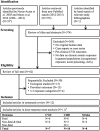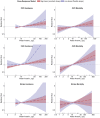A dose-response meta-analysis of chronic arsenic exposure and incident cardiovascular disease
- PMID: 29040626
- PMCID: PMC5837344
- DOI: 10.1093/ije/dyx202
A dose-response meta-analysis of chronic arsenic exposure and incident cardiovascular disease
Erratum in
-
A dose-response meta-analysis of chronic arsenic exposure and incident cardiovascular disease.Int J Epidemiol. 2018 Jun 1;47(3):1013. doi: 10.1093/ije/dyy073. Int J Epidemiol. 2018. PMID: 29697784 Free PMC article. No abstract available.
Abstract
Background: Consistent evidence at high levels of water arsenic (≥100 µg/l), and growing evidence at low-moderate levels (<100 µg/l), support a link with cardiovascular disease (CVD). The shape of the dose-response across low-moderate and high levels of arsenic in drinking water is uncertain and critical for risk assessment.
Methods: We conducted a systematic review of general population epidemiological studies of arsenic and incident clinical CVD (all CVD, coronary heart disease (CHD) and stroke) with three or more exposure categories. In a dose-response meta-analysis, we estimated the pooled association between log-transformed water arsenic (log-linear) and restricted cubic splines of log-transformed water arsenic (non-linear) and the relative risk of each CVD endpoint.
Results: Twelve studies (pooled N = 408 945) conducted at high (N = 7) and low-moderate (N = 5) levels of water arsenic met inclusion criteria, and 11 studies were included in the meta-analysis. Compared with 10 µg/l, the estimated pooled relative risks [95% confidence interval (CI)] for 20 µg/l water arsenic, based on a log-linear model, were 1.09 (1.03, 1.14) (N = 2) for CVD incidence, 1.07 (1.01, 1.14) (N = 6) for CVD mortality, 1.11 (1.05, 1.17) (N = 4) for CHD incidence, 1.16 (1.07, 1.26) (N = 6) for CHD mortality, 1.08 (0.99, 1.17) (N = 2) for stroke incidence and 1.06 (0.93, 1.20) (N = 6) for stroke mortality. We found no evidence of non-linearity, although these tests had low statistical power.
Conclusions: Although limited by the small number of studies, this analysis supports quantitatively including CVD in inorganic arsenic risk assessment, and strengthens the evidence for an association between arsenic and CVD across low-moderate to high levels.
Keywords: Arsenic; cardiovascular disease; dose-response; meta-analysis.
© The Author 2017; all rights reserved. Published by Oxford University Press on behalf of the International Epidemiological Association
Figures



References
-
- U.S. Environmental Protection Agency. Fiscal Year 2011 Drinking Water and Ground Water Statistics . EPA 816-R-13–003. March 2013. 2013. http://water.epa.gov/scitech/datait/databases/drink/sdwisfed/howtoaccess... (18 November 2015, date last accessed).
-
- Ayotte JD, Gronberg JM, Apodaca LE. Trace Elements and Radon in Groundwater Across the United States, 1992–2003. Scientific Investigations Report 2011–5059. 2011. http://pubs.usgs.gov/sir/2011/5059/pdf/sir2011–5059_report-covers_508.pdf (18 November 2015, date last accessed).
-
- Hutson SS, Barber NL, Kenney JF, Linsey KS, Lumia DS, Maupin MA. Estimated Use of Water in the United States in 2000:U.S. Geological Survey Circular 1268. 2004:http://pubs.usgs.gov/circ/2004/circ1268/ (18 November 2015, date last accessed).
Publication types
MeSH terms
Substances
Grants and funding
LinkOut - more resources
Full Text Sources
Other Literature Sources
Medical
Miscellaneous

